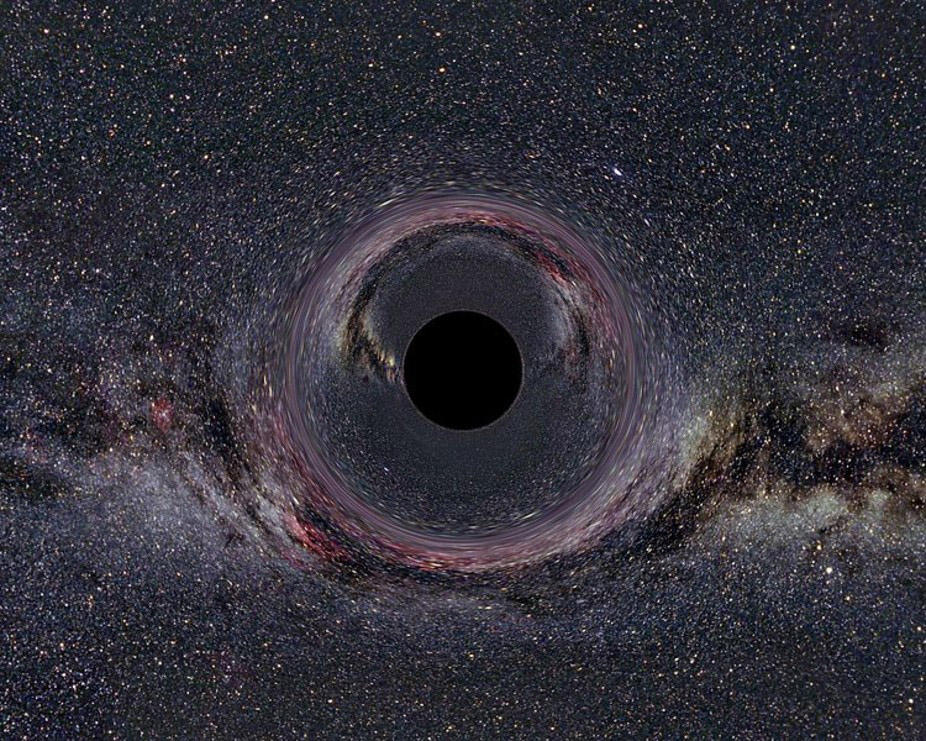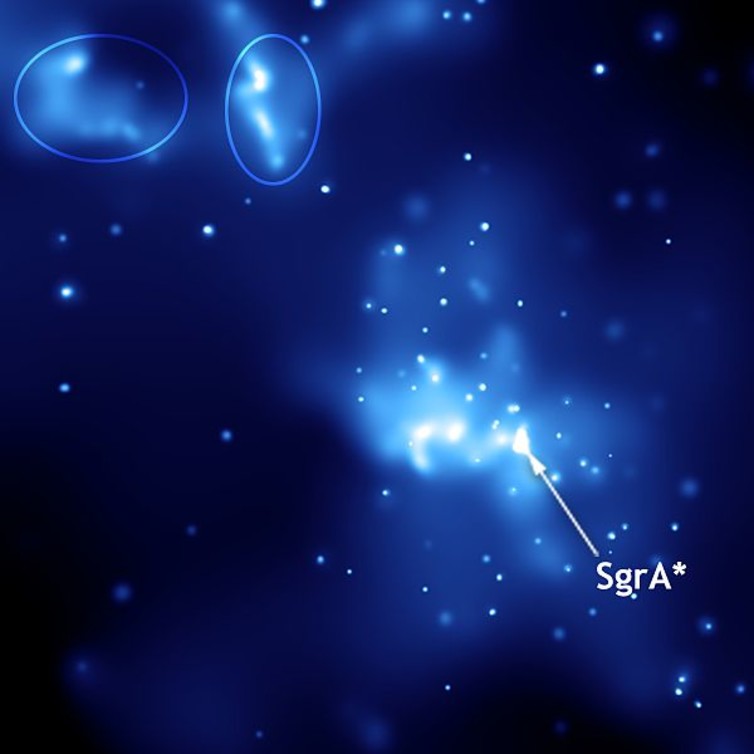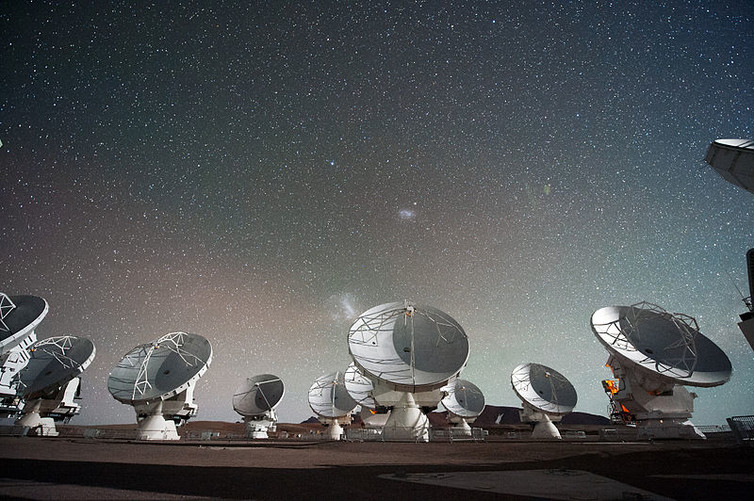Astronomers to Peer Into a Black Hole for 1st Time with Event Horizon Telescope


This article was originally published at The Conversation. The publication contributed the article to Space.com's Expert Voices: Op-Ed & Insights.
Black holes are regions of space inside which the pull of gravity is so strong that nothing – not even light – can escape. Their existence was predicted mathematically by Karl Schwarzchild in 1915, as a solution to equations posed in Albert Einstein's theory of general relativity.
Astronomers have had circumstantial evidence for many decades that supermassive black holes – a million to a billion times more massive than our sun – lie at the hearts of massive galaxies. That's because they can see the gravitational pull they have on stars orbiting around the galactic centre. When overfed with material from the surrounding galactic environment, they also eject detectable plumes or jets of plasma to speeds close to that of light. Last year, the LIGO experiment provided even more proof by famously detecting ripples in space-time caused by two medium-mass black holes that merged millions of years ago.
But while we now know that black holes exist, questions regarding their origin, evolution and influence in the universe remain at the forefront of modern astronomy.
Catching a tiny spot on the sky
On April 5-14 2017, the team behind the Event Horizon Telescope hopes to test the fundamental theories of black-hole physics by attempting to take the first ever image of a black hole's event horizon (the point at which theory predicts nothing can escape). By connecting a global array of radio telescopes together to form the equivalent of a giant Earth-sized telescope – using a technique known as Very Long Baseline Interferometry and Earth-aperture synthesis – scientists will peer into the heart of our Milky Way galaxy where a black hole that is 4m times more massive than our sun – Sagittarius A* – lurks.
Astronomers know there is a disk of dust and gas orbiting around the black hole. The path the light from this material takes will be distorted in the gravitational field of the black hole. Its brightness and colour are also expected to be altered in predictable ways. The tell-tale signature astronomers hope to see with the Event Horizon Telescope is a bright crescent shape rather than a disk. And they may even see the shadow of the black hole's event horizon against the backdrop of this brightly shining swirling material.
The array connects nine stations spanning the globe – some individual telescopes, others collections of telescopes – in Antarctica, Chile, Hawaii, Spain, Mexico and Arizona. The "virtual telescope" has been in development for many years and the technology has been tested. However, these tests initially revealed a limited sensitivity and an angular resolution that was insufficient to probe down to the scales needed to reach the black hole. But the addition of sensitive new arrays of telescopes – including the Atacama Large Millimeter Array in Chile and the South Pole Telescope – will give the network a much-needed boost in power. It's rather like putting on spectacles and suddenly being able to see both headlights from an oncoming car rather than a single blur of light.
Breaking space news, the latest updates on rocket launches, skywatching events and more!
The black hole is a compact source on the sky – its view at optical wavelengths (light that we can see) is completely blocked by large quantities of dust and gas. However, telescopes with sufficient resolution and operating at longer, radio millimetre wavelengths can peer through this cosmic fog.
The resolution of any kind of telescope – the finest detail that can be discerned and measured – is usually quoted as a small angle corresponding to the ratio of an object's size to its distance. The angular size of the moon as seen from the Earth is about half a degree, or 1800 arc seconds. For any telescope, the bigger its aperture, the smaller the detail that can be resolved.
The resolution of a single radio telescope (typically with an aperture of 100 metres) is roughly about 60 arc seconds. This is comparable to the resolution of the unaided human eye and about a sixtieth of the apparent diameter of the full moon. But by connecting many telescopes, the Event Horizon Telescope will be about to achieve a resolution of 15-20 microarcsecond (0,000015 arcseconds), corresponding to being able to spy a grape at the distance of the moon.
What's at stake?
Although the practice of connecting many telescopes in this way is well known, particular challenges lie ahead for the Event Horizon Telescope. The data recorded at each station in the network will be shipped to a central processing facility where a supercomputer will carefully combine all the data. Different weather, atmospheric and telescope conditions at each site will require meticulous calibration of the data so that scientists can be sure any features they find in the final images are not artefacts.
If it works, imaging the material inside the black hole region with angular resolutions comparable to that of its event horizon will open a new era of black hole studies and solve a number of big questions: do event horizons even exist? Does Einstein's theory work in this region of extreme strong gravity or do we need a new theory to describe gravity this close to a black hole? Also, how are black holes fed and how is material ejected?
It may even even be possible to image the black holes at the centre of nearby galaxies, such as the giant elliptical galaxy that lies at the heart of our local cluster of galaxies.
Ultimately, the combination of mathematical theory and deep physical insight, global international scientific collaborations and remarkable, tenacious long-term advances in cutting edge experimental physics and engineering look set to make revealing the nature of spacetime a defining feature of early 21st century science.
Carole Mundell, Head of Physics, University of Bath
This article was originally published on The Conversation. Read the original article. Follow all of the Expert Voices issues and debates — and become part of the discussion — on Facebook, Twitter and Google +. The views expressed are those of the author and do not necessarily reflect the views of the publisher. This version of the article was originally published on Space.com.


